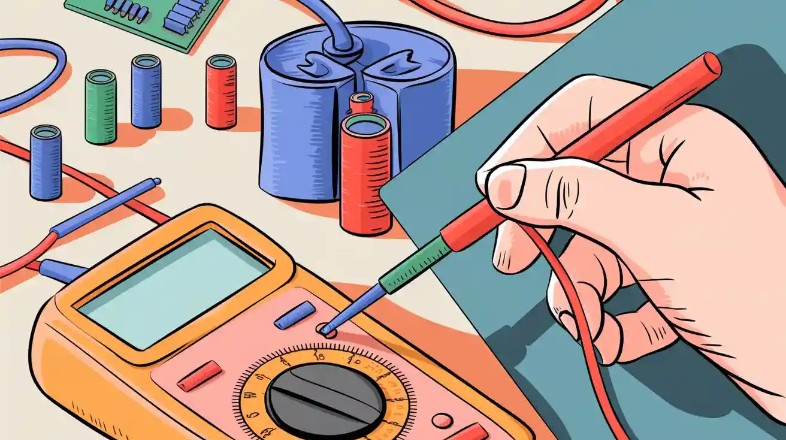
Capacitors are essential components in virtually every electronic device, from household appliances to complex industrial machinery. Understanding how to test a capacitor can save time, prevent equipment failure, and ensure safe repairs. At Origin Data Global Limited (ODG), we specialize in supplying electronic components, including capacitors, and supporting our customers with practical guidance for maintenance and troubleshooting.
Testing a capacitor might sound intimidating, but with the right tools and knowledge, it becomes a straightforward process. This guide will walk you through the steps to accurately test a capacitor, ensuring it functions as intended and identifying potential issues before they become costly problems.
Understanding the Role of a Capacitor
Before diving into the testing process, it’s important to understand what a capacitor does. Essentially, a capacitor stores and releases electrical energy in a circuit. It stabilizes voltage, filters signals, and can help start motors. Over time, capacitors can degrade, fail, or develop short circuits, making it crucial to test them regularly, particularly in critical applications.
Tools You Need for Testing
The primary tool for testing a capacitor is a multimeter. Modern digital multimeters often include a dedicated capacitance measurement function, making the process easier and more accurate. Additional tools you might need include:
Insulated screwdrivers for safely discharging capacitors
Safety gloves and glasses
Alligator clip leads for secure probe connections
Having the right tools ensures the test is both safe and reliable.
Safety First: Power Down and Discharge
Capacitors can store significant electrical charge even when a device is turned off. The first step in testing is to disconnect the power supply and fully discharge the capacitor.
To discharge:
Use an insulated screwdriver to bridge the terminals of the capacitor.
Confirm the capacitor has no residual charge with a multimeter set to voltage mode.
This step is crucial to prevent electric shocks and protect both the tester and the device.
Selecting the Correct Multimeter Mode
Once the capacitor is safely discharged, set your multimeter to the capacitance measurement mode. If your multimeter lacks this function, you can use the resistance mode, but this method is less precise. Ensure your multimeter is rated to handle the expected capacitance range of the component being tested.
Connecting the Probes
Proper probe placement is essential for an accurate reading:
Attach the positive (red) probe to the positive terminal of the capacitor.
Attach the negative (black) probe to the negative terminal.
For non-polarized capacitors, orientation doesn’t matter, but for electrolytic capacitors, correct polarity ensures safety and accuracy.
Reading and Interpreting Results
Once connected, the multimeter will display a value for the capacitor. Compare this reading to the capacitor’s rated capacitance, typically printed on its casing.
Within ±10% of the rated value: The capacitor is likely in good condition.
Significantly lower than rated value: The capacitor may be failing and should be replaced.
No reading or infinite resistance: The capacitor is likely shorted or open.
These results provide a clear indication of the capacitor’s health, allowing for timely replacement and maintenance.
Common Problems and Troubleshooting
Even with careful testing, capacitors can present challenges. Common issues include:
Leaking electrolytic capacitors: Visible signs of leakage or bulging indicate the capacitor should be replaced.
High ESR (Equivalent Series Resistance): Can cause circuits to underperform. An ESR meter can help detect these issues.
Intermittent faults: Some capacitors fail sporadically under load. In these cases, monitoring performance in the operational circuit is essential.
Understanding these nuances helps technicians and hobbyists make informed decisions.
Why Accurate Testing Matters
Testing capacitors accurately isn’t just about preventing immediate failure—it’s about ensuring long-term reliability of your electronic devices. A failed capacitor can lead to circuit instability, increased heat, and even damage to other components. By learning how to test a capacitor effectively, you can extend the lifespan of your electronics and avoid costly repairs.
ODG’s Role in Electronic Component Solutions
Origin Data Global Limited (ODG) goes beyond supplying capacitors and other electronic components. We specialize in sourcing obsolete, end-of-life, hard-to-find, and commonly used parts for OEMs around the world. Our extensive inventory and strong supplier network allow us to provide timely, reliable quotes and ensure fast delivery.
Our commitment to quality is evident in our rigorous QA system and professional QC team. ODG is a proud member of ERAI and holds certifications such as ESD, AS9120B, ISO9001, and ISO14001, ensuring all components meet the highest standards.
What sets ODG apart is our knowledgeable staff, who bring years of industry experience to help customers find the exact parts they need. Whether you require guidance on testing capacitors or sourcing specialized components, our team provides tailored solutions to meet unique requirements.
Practical Tips for Maintenance
Regular maintenance and periodic testing of capacitors can prevent unexpected failures. Some practical tips include:
Inspect capacitors for physical damage or leakage.
Test capacitors before installing them in critical circuits.
Keep multimeter batteries fresh for accurate readings.
Document test results to monitor trends and predict failures.
Applying these practices ensures your electronic systems operate efficiently and reliably.
Expanding Your Skills
Learning how to test a capacitor not only improves your technical capabilities but also enhances problem-solving skills when working with electronics. The ability to diagnose issues quickly and accurately can save valuable time and reduce dependency on external repair services.
By understanding capacitors and their testing methods, technicians and enthusiasts alike can gain a deeper appreciation of circuit functionality, reliability, and the importance of preventive maintenance.
Follow ODG:
YouTube: https://www.youtube.com/@Origin_Data Facebook: https://www.facebook.com/OriginDataGlobalLimited Twitter: https://twitter.com/Origin_IC Tiktok: